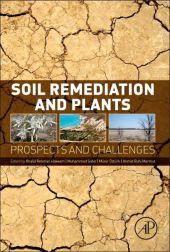 Neuerscheinungen 2014Stand: 2020-02-01 |
Schnellsuche
ISBN/Stichwort/Autor
|
Herderstraße 10
10625 Berlin
Tel.: 030 315 714 16
Fax 030 315 714 14
info@buchspektrum.de |

Khalid Hakeem, Ahmet Ruhi Mermut, Münir Öztürk, Muhammad Sabir
(Beteiligte)
Soil Remediation and Plants
Prospects and Challenges
Herausgegeben von Hakeem, Khalid; Sabir, Muhammad; Ozturk, Munir; Mermut, Ahmet Ruhi
2014. 752 S. 229 mm
Verlag/Jahr: ACADEMIC PRESS 2014
ISBN: 0-12-799937-X (012799937X)
Neue ISBN: 978-0-12-799937-1 (9780127999371)
Preis und Lieferzeit: Bitte klicken
The soil is being contaminated continuously by a large number of pollutants. Among them, heavy metals are an exclusive group of toxicants because they are stable and difficult to disseminate into non-toxic forms. The ever-increasing concentrations of such pollutants in the soil are considered serious threats toward everyone´s health and the environment. Many techniques are used to clean, eliminate, obliterate or sequester these hazardous pollutants from the soil. However, these techniques can be costly, labor intensive, and often disquieting.
Phytoremediation is a simple, cost effective, environmental friendly and fast-emerging new technology for eliminating toxic heavy metals and other related soil pollutants. Soil Remediation and Plants provides a common platform for biologists, agricultural engineers, environmental scientists, and chemists, working with a common aim of finding sustainable solutions to various environmental issues. The book provides an overview of ecosystem approaches and phytotechnologies and their cumulative significance in relation to solving various environmental problems.
Identifies the molecular mechanisms through which plants are able to remediate pollutants from the soil
Examines the challenges and possibilities towards the various phytoremediation candidates
Includes the latest research and ongoing progress in phytoremediation
1. Phytoremediation of Soils: Prospects and Challenges 2. Soil Contamination with Metals: Sources, Types and Implications 3. Phytoremediation: A Promising Strategy on the Crossroads of Remediation 4. Phytoremediation: Mechanisms and Adaptations 5. Phytoremediation: An Eco-Friendly Green Technology for Pollution Prevention, Control and Remediation 6. Recent Trends and Approaches in Phytoremediation 7. Evaluation of Four Plant Species for Phytoremediation of Copper-Contaminated Soil 8. Role of Phytoremediation in Radioactive Waste Treatment 9. Plant-Microbe Interactions in Phytoremediation 10. Soil Pollution in Turkey and Remediation Methods 11. Soil Pollution Status and Its Remediation in Nepal 12. Transfer of Heavy Metals and Radionuclides from Soil to Vegetables and Plants in Bangladesh 13. Remediating Cadmium-Contaminated Soils by Growing Grain Crops Using Inorganic Amendments 14. Phytoremediation of Pb-Contaminated Soils Using Synthetic Chelates 15. Spatial Mapping of Metal-Contaminated Soils 16. Arsenic Toxicity in Plants and Possible Remediation 17. Phytoremediation of Metal-Contaminated Soils Using Organic Amendments: Prospects and Challenges 18. Soil Contamination, Remediation and Plants: Prospects and Challenges 19. Improving Phytoremediation of Soil Polluted with Oil Hydrocarbons in Georgia 20. Remediation of Cd-Contaminated Soils: Perspectives and Advancements 21. Phytoremediation of Radioactive Contaminated Soils 22. Heavy Metal Accumulation in Serpentine Flora of Mersin-Findikpinari (Turkey) - Role of Ethylenediamine Tetraacetic Acid in Facilitating Extraction of Nickel 23. Phytomanagement of Padaeng Zinc Mine Waste, Mae Sot District, Tak Province, Thailand 24. Effect of Pig Slurry Application on Soil Organic Carbon


